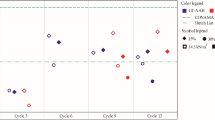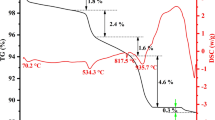Abstract
Chemical durability behavior of simulated crystalline oxyapatite wasteforms CaLa3.4Ce0.1Pr0.1Nd0.1Sm0.1Gd0.1Y0.1(SiO4)3O [WF-1] and Ca0.8Sr0.1Pb0.1La3.4Ce0.1Pr0.1Nd0.1Sm0.1Gd0.1Y0.1(SiO4)3O [WF-2] was studied. Soxhlet leach tests (MCC-5) were conducted and the leachates were analyzed by ICP-MS/OES techniques. The results indicate that the release of ions from the wasteform was found to be strongly dependent on chemical compositions, as WF-1 shows relatively more resistance towards leaching than parent and WF-2. The leachability of immobilized rare-earth ions in WF-1 and WF-2 was found to be negligible. The observed trend of leaching behaviour in all three systems is Si4+ > A2+ > RE3+. Further, the investigation on the mechanism of leaching suggested that the leaching process is predominantly governed by diffusion.
Graphic abstract









Similar content being viewed by others
References
Bruno J, Ewing RC (2006) Spent nuclear fuel. Elements 2:343–349
Choi JH, Cho IH, Eun HC, Park HS, Cho YZ, Lee KR, Park GI, Kim SH, Shin CH, Kim JK (2014) Fabrication and physical properties of lanthanide oxide glass wasteform for the immobilization of lanthanide oxide wastes generated from pyrochemical process. J Radioanal Nucl Chem 299:1731–1738
Campayo L, Le Gallet S, Perret D, Courtois E, Coumes CCD, Grin Y, Bernard F (2015) Relevance of the choice of spark plasma sintering parameters in obtaining a suitable microstructure for iodine-bearing apatite designed for the conditioning of I-129. J Nucl Mater 457:63–71
McMaster SA, Ram R, Faris N, Pownceby MI (2018) Radionuclide disposal using the pyrochlore supergroup of minerals as a host matrix—a review. J Hazard Mater 360:257–269
Rahman ROA, Rakhimov RZ, Rakhimova NR, Ojovan MI (2014) Cementitious materials for nuclear waste immobilization. Wiley, New York
Apted MJ (1990) Radionuclide release from high-level nuclear-waste packages. J Radioanal Nucl Chem 142:321–330
Bradley DJ (1980) Basic research for evaluating nuclear waste form performance. Nucl Technol 51:111–122
Peters MT, Ewing RC (2006) A science-based approach to understanding waste form durability in open and closed nuclear fuel cycles. No. MOL–20060815.0149. Yucca Mountain Project
Burakov BE, Anderson EB, Rovsha VS, Ushakov SV, Ewing RC, Lutze W, Weber WJ (1995) Synthesis of zircon for immobilization of actinides. Mater Res Soc Proc Libr Arch 412:33–40
Dacheux N, Clavier N, Podor R (2013) Monazite as a promising long-term radioactive waste matrix: benefits of high-structural flexibility and chemical durability. Am Miner 98:833–847
Shrivastava OP, Chourasia R (2008) Crystal chemistry of sodium zirconium phosphate based simulated ceramic waste forms of effluent cations (Ba2+, Sn4+, Fe3+, Cr3+, Ni2+ and Si4+) from light water reactor fuel reprocessing plants. J Hazard Mater 153:285–292
Cao C, Chong S, Thirion L, Mauro JC, McCloy JS, Goel A (2017) Wet chemical synthesis of apatite-based waste forms-A novel room temperature method for the immobilization of radioactive iodine. J Mater Chem A. 5:14331–14342
Sengupta P (2012) A review on immobilization of phosphate containing high level nuclear wastes within glass matrix—present status and future challenges. J Hazard Mater 235:17–28
Bennet DG, Higgo JJW, Wickham SM (2001) Review of waste immobilisation matrices. Nirex Limited, Oxfordshire
Ewing RC, Lutze W, Weber WJ (1995) Zircon: a host-phase for the disposal of weapons plutonium. J Mate Res 10:243–246
Lan WANG, Xirui LU, Xiaoyan SHU, Yi DING, Facheng YI, Dengsheng MA, Yanlin WU (2017) Chemical stability of simulated waste forms Zr1–xNdxSiO4–x/2: influence of temperature, pH and their combined effects. J Rare Earths 35:709–715
Li S, Liu J, Yang X, Ding Y, Zhu L, Liu B, Zhang L, Luo S, Lei J, Zhu W, Duan T (2019) Effect of phase evolution and acidity on the chemical stability of Zr1–xNdxSiO4-x/2 ceramics. Ceram Int 45–3:3052–3058
Terra O, Dacheux N, Audubert F, Podor R (2006) Immobilization of tetravalent actinides in phosphate ceramics. J Nucl Mater 352:224–232
Lumpkin GR (2006) Ceramic waste forms for actinides. Elements. 2:365–372
Montel JM, Glorieux B, Seydoux-Guillaume AM, Wirth R (2006) Synthesis and sintering of a monazite-brabantite solid solution ceramic for nuclear waste storage. J Phys Chem Solids 67:2489–2500
Terra O, Clavier N, Dacheux N, Podor R (2003) Preparation and characterization of lanthanum-gadolinium monazites as ceramics for radioactive waste storage. New J Chem 27:957–967
Donald IW, Metcalfe BL, Taylor RJ (1997) Review The immobilization of high level radioactive wastes using ceramics and glasses. J Mater Sci 32:5851–5887
Ojovan MI, Lee WE, Kalmykov SN (2019) An introduction to nuclear waste immobilization. Elsevier, Amsterdam
Trocellier P (2001) Chemical durability of high level nuclear waste forms. Ann Chim Sci des Mater 26:113–130
Hsieh YH, Humphry-Baker SA, Horlait D, Gregg DJ, Vance ER, Lee WE (2018) Durability of hot uniaxially pressed Synroc derivative wasteform for EURO-GANEX wastes. J Nucl Mater 509:43–53
Trocellier P, Delmas R (2001) Chemical durability of zircon. Nucl Instrum Methods Phys Res Sect B 181:408–412
Yi XIE, Long FAN, Xiaoyan SHU, Fangting CHI, Yi DING, Dengsheng MA, Xirui LU (2017) Chemical stability of Ce-doped zircon ceramics: influence of pH, temperature and their coupling effects. J Rare Earths 35:164–171
Teng Y, Zeng P, Huang Y, Wu L, Wang X (2015) Hot-pressing of monazite Ce0.5Pr0.5PO4 ceramic and its chemical durability. J Nucl Mater 465:482–487
Zhao X, Teng Y, Yang H, Huang Y, Ma J (2015) Comparison of microstructure and chemical durability of Ce0.9Gd0.1PO4 ceramics prepared by hot-press and pressureless sintering. Ceram Int 41:11062–11068
Ishida M, Kikuchi K, Yanagi T, Terai R (1986) Leaching behavior of crystalline phosphate waste forms. Nucl Chem Waste Manag 6:127–131
Jantzen CM (2011) Development of glass matrices for high level radioactive wastes. In: Handbook of advanced radioactive waste conditioning technologies. Woodhead Publishing
Hashimoto C, Nakayama S (2010) Immobilization of Cs and Sr to HZr2(PO4)3 using an autoclave. J Nucl Mater 396:197–201
Solomah AG, Richardson PG, Mcilwain AK (1987) Phase identification, microstructural characterization, phase microanalyses and leaching performance evaluation of SYNROC-FA crystalline ceramic waste form. J Nucl Mater 148:157–165
Murakami T, Banba T, Nakamura H (1986) Leaching of SYNROC-C: relation to microstructures. Nucl Technol 74:299–306
Ewing RC, Lutze W (1991) High-level nuclear waste immobilization with ceramics. Ceram Int 17:287–293
Hughes JM (2015) The many facets of apatite. Am Miner 100:1033–1039
Rakovan JF, Pasteris JD (2015) A technological gem: materials, medical, and environmental mineralogy of apatite. Elements 11:195–200
Clara M, Magalhães F, Williams PA (2007) Apatite group minerals: Solubility and environmental remediation. In: Thermodynamics, solubility and environmental issues. Elsevier, pp 327–340
Henderson P (ed) (2013) Rare earth element geochemistry. Elsevier, Amsterdam
Harouiya N, Chaïrat C, Köhler SJ, Gout R, Oelkers EH (2007) The dissolution kinetics and apparent solubility of natural apatite in closed reactors at temperatures from 5 to 50 C and pH from 1 to 6. Chem Geol 244:554–568
Chaïrat C, Schott J, Oelkers EH, Lartigue JE, Harouiya N (2007) Kinetics and mechanism of natural fluorapatite dissolution at 25 C and pH from 3 to 12. Geochim Cosmochim Acta 71:5901–5912
Rigali MJ, Brady PV, Moore RC (2016) Radionuclide removal by apatite. Am Miner 101:2611–2619
Maddrell ER, Abraitis PK (2003) A comparison of wasteforms and processes for the immobilisation of iodine-129. MRS Online Proceedings Library Archive. 807
Suetsugu Y (2014) Synthesis of lead vanadate iodoapatite utilizing dry mechanochemical process. J Nucl Mater 454:223–229
Campayo L, Grandjean A, Coulon A, Delorme R, Vantelon D, Laurencin D (2011) Incorporation of iodates into hydroxyapatites: a new approach for the confinement of radioactive iodine. J Mater Chem 21:17609–17611
Campayo L, Audubert F, Lartigue JE, Courtois-Manara E, Le Gallet S, Bernard F, Lemesle T, Mear FO, Montagne L, Coulon A, Laurencin D (2015) French studies on the development of potential conditioning matrices for iodine 129. MRS Online Proc Libr 1744:15–20
Guy C, Audubert F, Lartigue JE, Latrille C, Advocat T, Fillet C (2003) New conditionings for enhanced separated Long-lived radionuclides. C R Phys 3:827–837
Ravikumar R, Gopal B, Jena H (2018) Crystal chemical substitution at Ca and La Sites in CaLa4(SiO4)3O to design the composition Ca1−xMxLa4−xREx(SiO4)3O for nuclear waste immobilization and its influence on the thermal expansion behavior. Inorg Chem 57:6511–6520
Peterson JA, Crum JV, Riley BJ, Asmussen RM, Neeway JJ (2018) Synthesis and characterization of oxyapatite [Ca2Nd8(SiO4)6O2] and mixed-alkaline-earth powellite [(Ca, Sr, Ba)MoO4] for a glass-ceramic waste form. J Nucl Mater 510:623–634
Kim M, Heo J (2015) Calcium-borosilicate glass-ceramics wasteforms to immobilize rare-earth oxide wastes from pyro-processing. J Nucl Mater 467:224–228
Dacheux N, Kerdaniel EDD, Clavier N, Podor R, Aupiais J, Szenknect S (2010) Kinetics of dissolution of thorium and uranium doped britholite ceramics. J Nucl Mater 404:33–43
Kumar SP, Buvaneswari G (2013) Synthesis of apatite phosphates containing Cs+, Sr2+ and RE3+ ions and chemical durability studies. Mater Res Bull 48:324–332
Kumar SP, Gopal B (2016) New rare earth langbeinite phosphosilicates KBaREEZrP2SiO12 (REE: la, Nd, Sm, Eu, Gd, Dy) for lanthanide comprising nuclear waste storage. J Alloys Compd 657:422–429
Mimura H, Iijima K, Akiba K (1997) Leaching behavior and surface alteration of cesium aluminum silicate under static and dynamic conditions. J Nucl Sci Technol 34:269–276
Sugantha M, Kumar NRS, Varadaraju UV (1998) Synthesis and leachability studies of NZP and eulytine phases. Waste Manag 18:275–279
Cai X, Teng Y, Wu L, Zhang K, Huang Y (2016) The synthesis and chemical durability of Nd-doped single-phase zirconolite solid solutions. J Nucl Mater 479:455–460
Rafiuddin MR, Grosvenor AP (2018) An investigation of the chemical durability of hydrous and anhydrous rare-earth phosphates. J Nucl Mater 509:631–643
Kenna BT (1982) Analysis of long-term soxhlet tests. Nucl Chem Waste Manag 3:69–78
Njema H, Boughzala K, Boughzala H, Bouzouita K (2013) Structural analysis by Rietveld refinement of calcium and lanthanum phosphosilicate apatites. J Rare Earths 31:897–904
Carpéna J, Boyer L, Fialinc M, Kiénast JR, Lacout JL (2001) Ca2+, PO43− ⇌ Ln3+, SiO44− coupled substitution in the apatitic structure: stability of the mono-silicated fluor-britholite. C R Acad Sci IIA-Earth Planet Sci 333:373–379
Zhai D, Ning L, Huang Y, Liu G (2014) Ce−O covalence in silicate oxyapatites and its influence on luminescence dynamics. J Phys Chem C 118:16051–16059
Luo YR, Kerr JA (2012) Bond dissociation energies. In: CRC handbook of chemistry and physics, vol 89, p 89
Cote P (1986) Contaminant leaching from cement based wasteforms under acidic conditions. Doctoral dissertation
Zhao X, Teng Y, Wu L, Huang Y, Ma J, Wang G (2015) Chemical durability and leaching mechanism of Ce0.5Eu0.5PO4 ceramics: effects of temperature and pH values. J Nucl Mater 466:187–193
Plecas I, Dimovic S (2005) Immobilization of 137Cs and 60Co in concrete matrix. Part 2: mathematical modeling of transport phenomena. Ann Nucl Energy 32:1509–1515
Buvaneswari G, Varadaraju UV (2000) Low leachability phosphate lattices for fixation of select metal ions. Mater Res Bull 35:1313–1323
Harvey KB, Jensen CD (1982) An intercomparison of leach-testing methods and the effects of waste-form composition on test type and duration. Nucl Chem Waste Manag 3:43–50
Pearce EIF (1988) On the dissolution of hydroxyapatite in acid solutions. J Dent Res 67:1056–1058
Barkatt A, Gibson BC, Macedo PB, Montrose CJ, Sousanpour W, Barkatt A, Boroomand M, Rogers V, Penafiel M (2017) Mechanisms of defense waste glass dissolution mechanisms of defense waste glass dissolution. Nucl Technol 73:140–164
Simmons JH, Barkatt A, Macedo PB (1982) Mechanisms that control aqueous leaching of nuclear waste glass. Nucl Technol 56:265–270
Chick LA, Pederson LR (1983) The relationship between reaction layer thickness and leach rate for nuclear waste glasses. MRS Online Proceedings Library Archive. 26
Harvey KB (1995) Dissolution models for glassy waste forms (No. AECL-10738). Atomic Energy of Canada Ltd
Acknowledgements
The authors gratefully acknowledge the funding from UGC-DAE-CSR (CSR-KN/CRS-54/2013- 4/653) India and thank VIT, Vellore for providing all required facilities to carry out the experiments.
Funding
This study was funded by UGC-DAE-CSR (CSR-KN/CRS-54/2013- 4/653).
Author information
Authors and Affiliations
Corresponding author
Ethics declarations
Conflict of interest
The authors declare that they have no conflict of interest.
Additional information
Publisher's Note
Springer Nature remains neutral with regard to jurisdictional claims in published maps and institutional affiliations.
Electronic supplementary material
Below is the link to the electronic supplementary material.
Rights and permissions
About this article
Cite this article
Ravikumar, R., Gopal, B., Sekar, J.K. et al. Chemical durability studies on multi rare earths immobilized simulated oxysilicate apatite wasteforms CaLa3.4Ce0.1Pr0.1Nd0.1Sm0.1Gd0.1Y0.1(SiO4)3O and Ca0.8Sr0.1Pb0.1La3.4Ce0.1Pr0.1Nd0.1Sm0.1Gd0.1Y0.1(SiO4)3O. J Radioanal Nucl Chem 326, 1569–1578 (2020). https://doi.org/10.1007/s10967-020-07436-7
Received:
Accepted:
Published:
Issue Date:
DOI: https://doi.org/10.1007/s10967-020-07436-7




